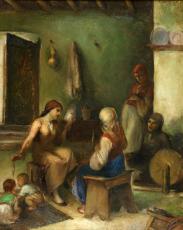


Ο Σολωμός Φραγκουλίδης σπούδασε στην Ανωτάτη Σχολή Καλών Τεχνών της Αθήνας από το 1924 έως το 1930. Από το 1925 εργάστηκε στο εργαστήρι του Γεώργιου Ιακωβίδη. Το κλίμα που επικρατούσε στη Σχολή των Αθηνών την εποχή της μαθητείας του αλλά και η διδασκαλία του Ιακωβίδη επηρέασαν καθοριστικά τους προσανατολισμούς και τις εικαστικές του επιλογές, ιδιαίτερα έως το 1947, χρονιά που επέστρεψε για να εγκατασταθεί οριστικά στην Κύπρο. Η επαφή του με τη φύση της κυπριακής υπαίθρου, η συνεχής παρατήρηση και μελέτη των μεταλλάξεών της και της σχέσης της με τις μεταβαλλόμενες εντάσεις και τον χαρακτήρα του φωτός τον απήλλαξαν από πολλούς περιορισμούς, οδηγώντας τον σε μια πιο ελεύθερη έκφραση. Όμως τα εφόδια που του έδωσε η επαφή με τον δάσκαλό του τον χαρακτήρισαν μέχρι το τέλος της εικαστικής του διαδρομής: η άρτια τεχνική και το στέρεο σχέδιο, η οργανωμένη δομή της σύνθεσης και η χρωματική αρμονία.
Το έργο Η Κουβεντούλα αν και δεν φέρει χρονολογία εκτέλεσης, είναι προφανές ότι ανήκει στην πρώτη περίοδο της καλλιτεχνικής του δημιουργίας και φιλοτεχνήθηκε κατά ή την περίοδο αμέσως μετά από την ολοκλήρωση των σπουδών του. Το θέμα του έργου είναι σαφώς επηρεασμένο από καλλιτέχνες της Σχολής του Μονάχου, όπως ο Νικόλαος Γύζης και ο Νικηφόρος Λύτρας, τη δουλειά των οποίων ο Φραγκουλίδης είχε ενδελεχώς μελετήσει. Ενδιαφέρουσα είναι η σύγκριση αυτής της ελαιογραφίας με άλλα δύο έργα από την Ελληνική Συλλογή της Λεβεντείου Πινακοθήκης: το έργο Η Ορφανή (1876) του Λύτρα και Οι Γειτόνισσες (π. 1880) του Γύζη. Το συγκεκριμένο έργο του Φραγκουλίδη έχει μια μοναδικότητα στην καλλιτεχνική του παραγωγή, γιατί ο ζωγράφος δεν επανέρχεται σε παρόμοια θέματα. Απεικονίζει μια συντροφιά τεσσάρων γυναικών να συνομιλούν ενώ εργάζονται γνέθοντας και μασουρίζοντας βαμβακερή κλωστή. Δίπλα, σε ένα μικρό χαλί, παίζουν αμέριμνα δύο μικρά παιδιά. Πρόκειται για μια σκηνή από την καθημερινότητα του κόσμου των γυναικών μιας λαϊκής –όπως δηλώνουν ο διάκοσμος του δωματίου και οι ενδυμασίες των γυναικών– οικογένειας. Η ηθογραφική αυτή σύνθεση δεν ανήκει στην εποχή του δημιουργού της, αλλά τοποθετείται στην Ελλάδα του 19ου αιώνα. Ο Φραγκουλίδης αποδίδει περιγραφικά και ρεαλιστικά το θέμα του. Η σκηνή διαδραματίζεται σε έναν κλειστό εσωτερικό χώρο και αποδίδεται με βαριά σκοτεινά χρώματα. Ο θεατρικός φωτισμός επικεντρώνεται στις δύο κεντρικές κύριες φιγούρες. Η σύνθεση οργανώνεται διαγώνια, με το βλέμμα του θεατή να οδηγείται από το κάτω αριστερό μέρος του πίνακα, όπου βρίσκονται τα δύο μικρά παιδιά, στο επάνω δεξιό. Η ευαίσθητη χρωματική επένδυση του έργου αποτελεί έναν διάλογο μεταξύ ψυχρών και θερμών χρωμάτων
Σπούδασε στο Σχολείο των Τεχνών της Αθήνας (πρόδρομη μορφή της Ανωτάτης Σχολής Καλών Τεχνών) το διάστημα 1924-1930 με καθηγητές τους Γεώργιο Ιακωβίδη, Νίκο Λύτρα, Σπυρίδωνα Βικάτο και Παύλο Μαθιόπουλο. Παρέμεινε στην Αθήνα έως το 1947, όπου εργάστηκε ως σχεδιαστής. Την περίοδο 1932-1934 αγιογράφησε την εκκλησία του χωριού Αγρός στην Κύπρο. Από το 1947 έζησε μόνιμα στην Κύπρο. Η θεματογραφία του περιλαμβάνει τοπία, προσωπογραφίες, νεκρές φύσεις και κάποιες συνθέσεις με θέματα κυρίως κοινωνικού περιεχομένου. Ασχολήθηκε επίσης με την αγιογραφία. Σταθερά χαρακτηριστικά της ζωγραφικής του, η σχεδιαστική αρτιότητα, η πίστη στην τεχνική και η ισορροπημένη σύνθεση. Στις τοπιογραφίες του, που κυριαρχούν στις θεματικές του, έχει ως αφετηρία την υπαιθριστική ζωγραφική, ενώ προχωρεί για να κατακτήσει διδάγματα των Ιμπρεσιονιστών, ιδιαίτερα σε ό,τι αφορά τις μεταλλαγές της φύσης υπό την επίδραση του φωτός. Παρουσίασε το έργο του σε ατομικές εκθέσεις στην Αθήνα (1936, 1937, 1976), στην Κύπρο (1953, 1966, 1974,1977), στο Λονδίνο (1972) και σε πολλές ομαδικές. Τιμήθηκε με αργυρό μετάλλιο στην Biennale Internazionale d’Arte Sacra στη Foggia της Ιταλίας (1972).